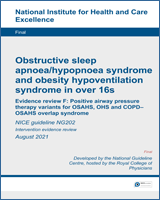From: Positive airway pressure therapy variants for OSAHS, OHS and COPD–OSAHS overlap syndrome

NCBI Bookshelf. A service of the National Library of Medicine, National Institutes of Health.
| Outcomes |
No of Participants (studies) Follow up | Quality of the evidence (GRADE) | Relative effect (95% CI) | Anticipated absolute effects | |
|---|---|---|---|---|---|
| Risk with Control | Risk difference with NIV versus fixed CPAP (95% CI) | ||||
|
Machine usage (hours/night) Follow-up 4 to 52 weeks |
268 (4 studies) |
⊕⊕⊝⊝ LOW11, due to risk of bias, | control group risk not available4 |
The mean machine usage (hours/night) in the intervention groups was 0.14 higher (0.17 lower to 0.45 higher) | |
|
Symptoms (Epworth Sleepiness Scale) Scale from 0-24 Higher is worse Follow-up 4 to 12 weeks |
226 (4 studies) |
⊕⊝⊝⊝ LOW11, due to risk of bias, | control group risk not available4 |
The mean symptoms (epworth sleepiness scale) in the intervention groups was 0.49 lower (1.46 lower to 0.48 higher) | |
|
Withdrawals (parallel group trials/first arm cross-over trials) Follow-up 4 to 52 weeks |
261 (3 studies) |
⊕⊝⊝⊝ due to risk of bias, imprecision |
RR 0.61 (0.33 to 1.15) | Moderate | |
| 138 per 1000 |
54 fewer per 1000 (from 92 fewer to 21 more) | ||||
|
Quality of life (Functional Outcome of Sleep Questionnaire) Scale from 5-20 higher is better Follow-up 8 weeks |
151 (1 study) |
⊕⊕⊝⊝ due to risk of bias, imprecision |
Mean in control group was 5.1 |
The mean quality of life (functional outcome of sleep questionnaire) in the intervention groups was 0.8 lower (6.08 lower to 4.48 higher) | |
|
Quality of life (Sleep Association Quality of Life Index) Scale 1-7 Higher is better |
28 (1 study) |
⊕⊕⊕⊝ MODERATE1 due to risk of bias | control group risk not available4 |
The mean quality of life (sleep association quality of life index) in the intervention groups was 0.4 higher (0.34 lower to 1.14 higher) | |
|
Quality of life (SF-36 questionnaire) - Physical health Scale from 0-100 Higher is better |
151 (1 study) |
⊕⊝⊝⊝ due to risk of bias, imprecision |
Mean in control group was 1.2 |
The mean quality of life (sf-36 questionnaire) - physical health in the intervention groups was 0.6 higher (2.21 lower to 3.41 higher) | |
|
Quality of life (SF-36 questionnaire) - Mental heath Scale from 0-100 Higher is better |
151 (1 study) |
⊕⊕⊝⊝ due to risk of bias, imprecision |
Mean in control group was 4.6 |
The mean quality of life (sf-36 questionnaire) - mental health in the intervention groups was 2.9 lower (7.09 lower to 1.29 higher) | |
|
Apnoea Hypopnoea Index (events/hr) Lower is better Follow-up 4 to 8weeks |
179 (2 studies) |
⊕⊝⊝⊝ due to risk of bias, imprecision |
The mean AHI was 6.6 events/hour |
The mean apnoea hypopnoea index (events/hr) in the intervention groups was 1.36 higher (6.92 lower to 9.63 higher) | |
| Patient preference - BiPAP/no preference or CPAP |
88 (2 studies) |
⊕⊝⊝⊝ due to risk of bias, inconsistency, imprecision |
RR 0.88 (0.47 to 1.65) | Moderate | |
| 545 per 1000 |
65 fewer per 1000 (from 289 fewer to 354 more) | ||||
|
Tolerability outcomes - Dry mouth Follow-up 4 to 52 weeks |
151 (1 study) |
⊕⊝⊝⊝ due to risk of bias, imprecision |
RR 0.56 (0.15 to 2.17) | Moderate | |
| 75 per 1000 |
33 fewer per 1000 (from 64 fewer to 88 more) | ||||
|
Tolerability outcomes - Mask intolerance Follow-up 4 to 52 weeks |
151 (1 study) |
⊕⊝⊝⊝ due to risk of bias, imprecision |
RR 1.13 (0.45 to 2.85) | Moderate | |
| 100 per 1000 |
13 more per 1000 (from 55 fewer to 185 more) | ||||
|
Treatment comfort score 0-100 VAS Follow-up 4 to 52 weeks |
28 (1 study) |
⊕⊕⊝⊝ due to risk of bias | control group risk not available4 |
The mean treatment comfort score in the intervention groups was 9 higher (3.54 lower to 21.54 higher) | |
Downgraded by 1 increment if the majority of the evidence was at high risk of bias, and downgraded by 2 increments if the majority of the evidence was at very high risk of bias
Downgraded by one increment if the confidence interval crossed one MID and downgraded by two increments if the confidence interval crossed both MIDs. MID for machine usage (adherence)- 1 hour ; Established MIDs for SF-36 physical/mental- 2/3 ; FOSQ- 2 ; ESS −2.5; SAQLI – 2 3 SAQLI- established MID 2.. GRADE default MID (0.5XSD) used for all other continuous outcomes.
Downgraded by 1 or 2 increments for heterogeneity. Random effect analysis used.
Cochrane review used mean difference (SE) in the analysis, control group risk data not available.
From: Positive airway pressure therapy variants for OSAHS, OHS and COPD–OSAHS overlap syndrome

NCBI Bookshelf. A service of the National Library of Medicine, National Institutes of Health.